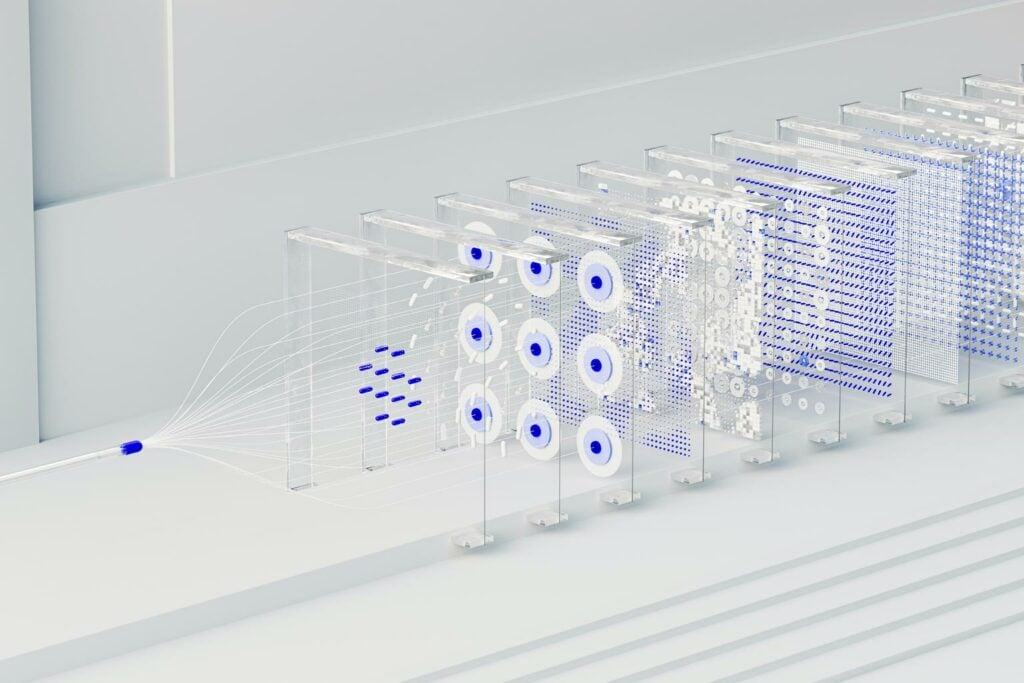As artificial intelligence (AI) innovation continues to grow, companies are racing to develop the next game-changing algorithm, machine learning tool, AI bot, computer vision technology, and more. With the AI market set to hit $1.6 billion by 2030, companies that prioritize AI innovation will surge ahead of the pack. However, it is not enough to simply prioritize creation and development. Patenting AI algorithms can transform them into a significant competitive advantage for your business, enhancing your artificial intelligence products and services.
AI patents have grown exponentially over the past several years, with AI patent filings growing 100% and now making up 42% of technology patents. More recently, AI has come to be adopted by the everyday consumer as ChatGPT saw 100 million users in one month, making it the fastest-growing application in history, and consequently leading Microsoft to invest another $10 billion into the technology. As AI becomes an integral part of everyday life, companies need to learn how protecting these innovations creates unparalleled opportunities but also comes significant challenges. This article will provide a detailed breakdown of the protections available for your AI algorithm and the critical role of patent protection for your algorithms.
What Are AI Algorithms?
Algorithms are one of the most useful AI tools. An algorithm is defined as “a procedure for solving a problem or performing a computation.” The most familiar context most people first hear the use of the word in are social media companies, with platforms like Facebook, Instagram, and TikTok constantly notifying users of updates to their proprietary algorithms that produce recommended content personalized to the individual user.
Machine learning algorithms make up 40% of AI IP cases, but natural language processing and computer vision technologies are also emerging in the AI algorithm IP landscape. The main distinction with natural language processing models is that they focus more on the computer-human language interaction and how to analyze vast amounts of language data. Similarly, computer vision algorithms comprise instructions that are used to process visual data from the surrounding environment.
Take Instagram for example, which has several algorithms for different features like the feed, Stories, Reels, Discover page, and more, all serving fresh content to users based on content relevance, newness, and user interaction activity.
Algorithms provide a plethora of tangible benefits to a product or company, primarily enhanced problem solving, improved efficiency, and reduced complexity. Many of these are the product of algorithms’ automation of repetitive tasks and creation of simple or complex step-by-step processes to solve a problem. Algorithms learn upon themselves after receiving inputs, and after a series of continuous learning, can improve, thus becoming more granular and accurate.
Take for example the algorithm Instagram uses for its Stories feature, which might look at metrics and behaviors like time viewed, actions taken, or swipes, and determine whether similar content should be shown to the individual user again. As it learns more about your behavior from your interaction with the Stories, it often becomes more accurate, leading to that eerie feeling of seeing an ad for something that you may have thought about recently.
Can You Patent an AI Algorithm? What You Need to Know
While it might seem like a simple “yes” or “no” response, the real answer is anything but simple. AI has been the subject of many challenges and scrutiny when it comes to intellectual property rights such as concerns over whether an AI can be considered an inventor or if the given technology is even patentable.
Considering an algorithm is a type of machine learning mechanism, businesses and startups can bring two different types of patent claims: a computer-implemented method or a device and storage medium claim. The former refers to inventions that require use through a computer, a computer network, or some programmable apparatus, and it directly protects your invention from an infringing technology that follows the same steps.
How to Patent an Algorithm: Step-by-Step
Patenting AI algorithms is a complex process best guided by an experienced IP lawyer who specializes in AI. In a few steps, you can set up your machine learning algorithm for patent status with a strong claim that is ultimately successful.
1. Determine Whether the Algorithm Is Patentable
At the outset, there are a few questions you must consider when determining if an AI can be patentable, and this applies to algorithms as well.
- Is it made by human inventors?
- Is it a new or novel idea?
- Is it non-obvious or does it include an inventive step?
Answering “yes” to these questions covers the start of the process that ensures your invention is eligible for patenting. Because an algorithm on its own may be considered an abstract idea, it is not inherently patentable. However, an algorithm may be patentable if it includes novel and nonobvious functions or steps, improves the performance of computer hardware, or is used in a novel application.
For the best and most comprehensive understanding of the patentability of your algorithm, we recommend working with a licensed patent attorney who’s experienced with AI patents. They know the requirements of the USPTO with respect to patents, and how to highlight the novelty within your AI algorithm patents.
2. Search the Patent Database
Next, you want to ensure your patent isn’t infringing on others, and this is also a good time to explore competitor’s algorithm patent applications. You may start by searching the open repository of Google Patents offered by Google or the Patent Public Search tool offered by the U.S. Patent and Trademark Office. However, many inventors make the mistake of thinking that their own independent search is a sufficient patent search. While this step sounds relatively simple on the surface, a thorough research requires the expert eye of an attorney who knows precisely what to look for.
We recommend working with a patent attorney with experience in AI-based software to perform a thorough prior art search of databases other than Google or the USPTO database. Their experience with AI patents and the USPTO database allows them to perform a complete and comprehensive database search of the millions of patents already issued and many more applications published.
3. Start Putting Together the Description of Your AI Algorithm Patent Claims
Now it’s time to put together the specifics. Algorithms can be patented when their practical application is technical, meaning they solve an existing problem with a new technique or method, (such as a product recommendation engine on Amazon), or identify, classify, organize, and present information in a new way, (such as the Google search algorithm).
Specifically for algorithms, it’s helpful to identify the following:
- The algorithm’s name
- The computer program it runs on
- A description of what the algorithm does
- A description of how the algorithm functions, step-by-step
- The detailed problem the algorithm solves
- First-hand knowledge of the algorithm
When it comes to AI algorithm patent application, it’s helpful to be as detailed and specific as possible, especially when it comes to detailing the application of the algorithm. As alluded to earlier, you need to break down your algorithm into a series of steps and explain how it solves a real-world problem when you are describing how it works. With algorithm application patents becoming increasingly popular and showing no signs of slowing down, your descriptions in this step must be as thorough as possible.
Knowledge, experience, and skill are required for a thorough and complete description of the application of your algorithm at this stage of the patenting application drafting process. Working with the right attorney can mean the difference between approval and denial of your patent application.
Proficient patent attorneys know how to draft claims around the uniqueness of your invention and with infringement in mind. There are specific legal and technical parameters that experienced attorneys know how to leverage in gaining patent protection.
4. Hire a Patent Attorney AI Algorithm Patent Claims
New AI innovations are being implemented throughout nearly every industry every month, and successfully filing an AI algorithm patent application is a time-consuming, complex process riddled with technical and legal nuances. From determining if an invention is eligible for patent protection to digging through potentially hundreds of thousands of previously filed patents to crafting a strong patent application with a high likelihood of success, it’s difficult to feel the confidence and assurance that your invention is fully protected to the greatest extent possible.
Working with an expert team of patent attorneys with plentiful experience specifically in AI is the right decision for protecting one of your most valuable assets, reducing risk, and providing peace of mind. At the Rapacke Law Group, we will walk you through the type of IP protections that are best fit for your situation and guide you in avoiding the most common pitfalls that arise with the first three steps outlined above.
Case Studies: Machine Learning Patent Examples
One of the most useful strategies to put together your successful patent filing is to search what other comparable companies have done before you. Here are a few recent software patent examples.
Coinbase’s Instant Exchange System
Through Patent #US10614430B2 issued in 2020, a leading cryptocurrency company, Coinbase, patented its instant exchange system and method for the transaction of bitcoin. The algorithm allows for the instant exchange of bitcoin between merchant and customer without a miner’s fee.
Airbnb’s Algorithm for Booking
From Patent #US10805315B2, short-term and long-term rental company Airbnb successfully procured protection for its machine learning algorithm that determined the likelihood of a property being booked. This predictive computer model was constantly learning and improving upon itself after receiving inputs.
Google’s Patent on “Dropout”
Google’s patent on the concept of dropout in machine learning is an example of a broad patent most likely meant to steer any other competitors from using this technology. Within patent #US9406017B2, Google has safeguards around the common principle of disregarding certain inputs during the learning process.
Speak With an Experienced Patent Attorney about Patenting AI Algorithms
When deciding to patent an AI algorithm or invention, consider working with an experienced patent attorney to secure your invention properly. Forward-thinking businesses are determining their competitive advantage for years to come right now, and at Rapacke Law Group, we specialize in supporting companies through the entire AI patent filing process. Contact us today.




